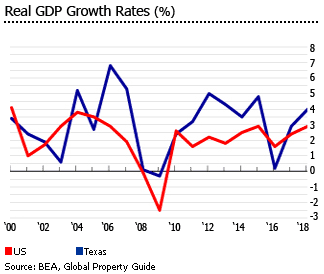Texas'housing market boom continues
Lalaine C. Delmendo | December 16, 2019

The Texas housing market is expected to remain vibrant, because of attractive combination of strong growth, high rental yields ranging from 6.4% to 13.3%, yet lower house prices than other states - so investors can earn well. However the rental vacancy rate is high, i.e., investors need to take care where they buy.
The Federal Housing Finance Agency's seasonally-adjusted purchase-only Texas house price index rose by 4.88% during the year to Q3 2019 (3.07% inflation-adjusted), down from 5.94% the same time last year.
The median home price increased 4.3% to US$245,000 in Q3 2019 from a year earlier, according toTexas Realtors. In Dallas-Forth Worth-Arlington area (30% of the Texas market) the median price rose by 3.6% y-o-y to US$275,501 in Q3 2019. The median price increased 4.7% to US$247,000 in Houston-The Woodlands-Sugar Land, 4% to US$235,000 in San Antonio-New Braunfels, and 3.9% to US$319,900 in Austin-Round Rock area.
Sales continue to rise thanks to strong US demand, despite less purchases by foreigners. Sales rose by 6.4% in Q3 2019 from a year earlier, a sharp improvement from y-o-y rises of 1% in Q2 and 0.7% in Q1, according to Texas Realtors.

Residential construction is increasing. New privately-owned housing units authorized in Texas rose by 7.3% in the first ten months of 2019 to 168,006 units, following annual growth of 10.1% in 2018 and 5.6% in 2017, according to the US Census Bureau.
The Texas economy is the second largest in the U.S., next to California. Texas' population is 28.7 million people – around 8.8% of the country's total. In fact if Texas was a country, its economy would be the tenth largest in the world, at US$1.8 trillion. However its median household income of US$60,629 was slightly lower in 2018 than the national average of US$61,937.
Analysis
of United States Residential Property Market »
Robust economic growth, low unemployment
The Texas economy expanded by an annualized rate of 4.7% in Q2 2019 – the highest growth among the 50 US states, according to the US Bureau of Economic Analysis.With the ongoing US-China trade war, the state’s performance is impressive. Texas is the top exporting US state, accounting for almost 20% of US exports.
“The Q2 GDP growth number for Texas is indicative of the continued strength and diversity of the Texas economy,” said Texas Comptroller Glenn Hegar. “While some of this growth is attributable to a corresponding uptick in mining sector activity during the second quarter, continued diversification of the Texas economy has made our state less reliant on a single sector to drive economic growth. That is part of the reason for Texas’ greater growth even among energy producing states.”

However Texas will suffer severe consequences if the United States-Mexico-Canada Agreement (USMCA) – the replacement of the 25-year old NAFTA –isn't ratified soon, given the state’s close trade ties with both Mexico and Canada, some legislators warned.
“We believe that no state will gain more from this new agreement than Texas, and no state has more to lose if it doesn’t pass than our state,” said US Representative Kevin Brady.
Trade with Mexico and Canada supports about 1 million jobs in Texas and was worth US$230 billion last year, according to the US Chamber of Commerce.
The state’s economy grew by a robust 4% in 2018, following expansions of 2.9% in 2017, 0.2% in 2016, 4.8% in 2015 and 3.5% in 2014.
Unemployment was at a record low of 3.4%, down from 3.7% a year earlier, according to the US Bureau of Labor Statistics (BLS).